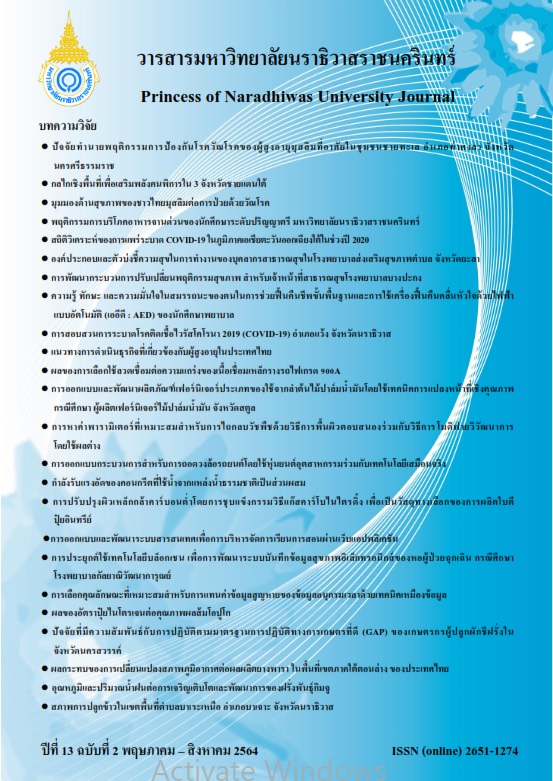ผลของอัตราปุ๋ยไนโตรเจนต่อคุณภาพผลส้มโอปูโก
คำสำคัญ:
ปุ๋ยไนโตรเจน, ส้มโอ, ปูโก, คุณภาพผลบทคัดย่อ
ผลของอัตราปุ๋ยไนโตรเจนต่อคุณภาพผลส้มโอปูโก ดำเนินการระหว่างเดือนมีนาคม 2561 ถึง กุมภาพันธ์ 2562 ในแปลงส้มโอของเกษตรกรในตำบลเมาะมาวี อำเภอยะรัง จังหวัดปัตตานี โดยมีวัตถุประสงค์เพื่อทดสอบการใช้ปุ๋ยไนโตรเจน 3 อัตรา คือ 1) การให้ไนโตรเจนอัตรา 1 กิโลกรัมต่อต้น 2) การให้ไนโตรเจนอัตรา 2 กิโลกรัมต่อต้น และ 3) การให้ไนโตรเจนอัตรา 3 กิโลกรัมต่อต้น ทำการเก็บผลส้มโอเมื่ออายุ 28 สัปดาห์หลังดอกบาน จากการศึกษาพบว่า การให้ปุ๋ยไนโตรเจนอัตราต่าง ๆ ไม่มีผลต่อจำนวนช่อดอกต่อกิ่ง เปอร์เซ็นต์การติดผล น้ำหนักผล ความกว้าง และความสูงของผล ของแข็งที่ละลายน้ำ เปอร์เซ็นต์กรด วิตามินซี และคลอโรฟีลล์ การให้ปุ๋ยไนโตรเจนอัตรา 3 กิโลกรัมต่อต้นให้เนื้อผลที่มีน้ำตาลซูโครส กลูโคส ฟรุกโตส น้ำตาลทั้งหมด และไลโคปีนสูงสุดเท่ากับ 98.6, 31.2, 11.7, 141.5 (กรัม/ลิตร) และ 2.15 (มิลลิกรัม/100 มิลลิลิตร) ตามลำดับ แตกต่างอย่างมีนัยสำคัญทางสถิติกับต้นส้มโอที่ได้รับปุ๋ยไนโตรเจนอัตรา 1 และ 2 กิโลกรัมต่อต้น ในขณะที่การให้ปุ๋ยไนโตรเจนอัตรา 1 กิโลกรัมต่อต้นให้เนื้อผลที่มีลิโมนิน และเบต้าเคโรทีนสูงสุด เท่ากับ 3.9 มิลลิกรัม/ลิตร และ 0.64 มิลลิกรัม/100 มิลลิลิตร และให้ไลโคปีนต่ำสุด 1.37 มิลลิกรัม/100 มิลลิลิตร จากการศึกษาสรุปได้ว่าส้มโอปูโกที่ได้รับปุ๋ยไนโตรเจนในอัตราสูงให้ผลที่มีคุณภาพดีกว่าการให้ในอัตราต่ำเนื่องจากไนโตรเจนเป็นธาตุที่ส้มโอขาดมากที่สุด
เอกสารอ้างอิง
Agocs, A., Nagy, V., Szabo, Z., Mark, L., Ohmacht, R., & Deli, J. (2007). Comparative study on carotenoid composition of the peel and the pulp of different citrus species. Innovative Food Science and Emerging Technology, 8, 390-394.
Alva, A.K., Paramasivam, S., Obreza, T.A., & Schumann, A.W. (2006). Nitrogen best management practice for citrus trees I. Fruit yield, quality, and leaf nutritional status. Scientia Horticulturae, 107, 233-244.
AOAC, (2000). Official Methods of Analysis of AOAC International. Gaithersburg MD: AOAC International.
Boland, F.E. (1995). Acidity (titratable) of fruit products. In (Cunniff, P. Ed), Official Methods of Analysis of the Association Official Analytical Chemist International. Virginia: AOAC international.
Chen, F., Lu, J., & Liu, D. (2007). Investigation of soil fertility in citrus orchards of southern China. Better Crops with Plant Food, 91, 24-25.
Dandekar, D.V., Jayaprakaha, G.K., & Patil, B.S. (2008). Hydrotrooic extraction of bioactive limonin from sour orange (Citrus aurantium L.) seeds. Food Chemistry, 109(3), 515-520.
Hewitt, E. J. (1984). The essential and functional mineral element. In Diagnosis of Mineral disorder in plant. Chemical: New York.
Kaewtubtim, M., (2020). Nutrients concentration in soil, leaf, fruit and effects of limited nutrients on fruit quality of Puko pummelo. Research report of Office of Extension and Services, Prince of Songkla University. (in Thai)
Kaewtubtim, M., (2019). Development guidelines of pummelo gardener for income development in the southern border provinces. Journal of Economic Development and Sociology, Southern Border Provinces, 1(2), 26-31.
Kaewtubtim, M., (2018). Assessment of nutrient concentration in soil and leaves of Puko pummelo grown in Pattani province. In National academic research conference graduate network northern region Rajabhat University 18 th and Lampang 4 th research, 20 July 2018 Lampang: Lampang Rajabhat University. (in Thai)
Kaewtubtim, M., Issarakrisila, M., & Maneepong, S. (2016). Effect of nitrogen on fruit quality of pummelo (Citrus grandis (L.)Osbeck) cv. Tubtim Sayam. KKU Science Journal, 44, 518-529.
Kaewtubtim, M. (2014). Effects of fruit maturity, tree age, nitrogen and zinc on fruit quality of pummelo cv. Tubtim Sayam. A Dissertaion Submitted in Partial Fulfillment of the Requirements for the Doctor of Philosophy School of Agricultural Technology Walailak University. (In Thai).
Kays, S.J. (1999). Preharvest factors affecting appearance. Postharvest Biology and Technology, 15, 233-247.
Louis, C.L., Ai, I., Salma, H., Jube, B., & Madduri, V. R. (2010). Assessment of lycopene content of fresh tomato and tomato products in the United Emirates. Journal of Food Agricultural and Environment, 8, 142-147.
Maneepong, S. (2008). Nutrient management for the production of quality Pummelo. Nakorn Si Thammarat: Walailak University. (in Thai)
Maneepong, S. (2009). A nutrients survey for establishment of standard recommendation of soil and plant analysis for pummelo. In The 7th National Horticultural Congress (Page 36), Phisanuloke: Naresuan University. (in Thai).
Marschner, H. (1995). Mineral nutrition of higher plants. New York: Academic Press.
Mengel, K., Kirkby, E. A., Kosegarten, H., & Appel, T. (2001). Principles of plant nutrition. Dordrecht, the Netherlands: Kluwer Academic Publishers.
Nagata, M., & Yamashita, I. (1992). Simple method for simultaneous determination of chlorophyll and carotenoids in tomato fruit. Nippon Shokuhin Kogyo Gakkaishi. 39, 925-928.
Niramon, T. (2006). Effect of postharvest irradiation on pigmentation changes in mango fruit cv. Mahajanaka. Journal of Agricultural Science, 39(3)(Suppl.), 44-47.
Osotsapa, Y. (2000). Plant Nutrient. Bangkok: Kasetsart University. (in Thai).
Pan, Z., Zeng, Y., An, J., Ye, J., Xu, Q., & Deng, X. (2012). An integrative analysis of transcriptome and proteome provides new insights into carotenoid biosynthesis and regulation in sweet orange fruits. Journal of Proteomics, 75, 2670-2684.
Rodrigo, M.J., & Zacarias, L. (2006). Effect of postharvest ethylene treatment on carotenoid accumulation and expression of carotenoid biosynthetic genes in the flavedo of orange fruit. Postharvest Biology and Technology, 43, 14-22.
Sethpakdee, R. (2001). Physiology and physiological disorders in citrus. In Science Training Orange: Current options for the future. (Page 3/1-3/21). Bangkok: Office of Extension and Training of Kasetsart University. (in Thai)
Serna, M.D., Borras, R., Legaz, F., & Primo-Millo, E. (1992). The influence of nitrogen concentration and ammonium/nitrate ratio on N-uptake, mineral composition and yield of citrus. Plant and Soil. 147, 13-23.
Siriphanich, J. (2003). Physiology and postharvest technology of fruits and vegetables. Bangkok : Kasetsart University. (in Thai)
Skrede, G., & Wrolstad, R.E. (2002). Flavanoids from berries and grapes. In Functional Foods. Boca Ration: CRC press.
Tariq, M., Sharif, M., Shah, Z., & Khan, R. (2007). Effect of foliar application of micronutrients on the yield and quality of sweet orange. Pakistan Journal of Biological Sciences. 10, 1823-1828.
Tucker, D.P.H., Alva, A.K., Jackson, L.K., & Wheaton, T.A. (1995). Nutrition of Florida citrus trees. University of Florida, Cooperative Extension Service, Gainnesville, Florida.
Warren, C. R., Adam, M. A., & Chen, Z. (2000). Is photosynthesis related to concentrations of nitrogen and rubisco in leaves of Australian native plants. Australia Journal Plant Physiology, 27, 407-416.
Zekri, M., & Obreza, T.A. (2006). Plant nutrients forcitrus tree. Retrieved May 22, from http://ed isifas.ufl.edu/ss419.




